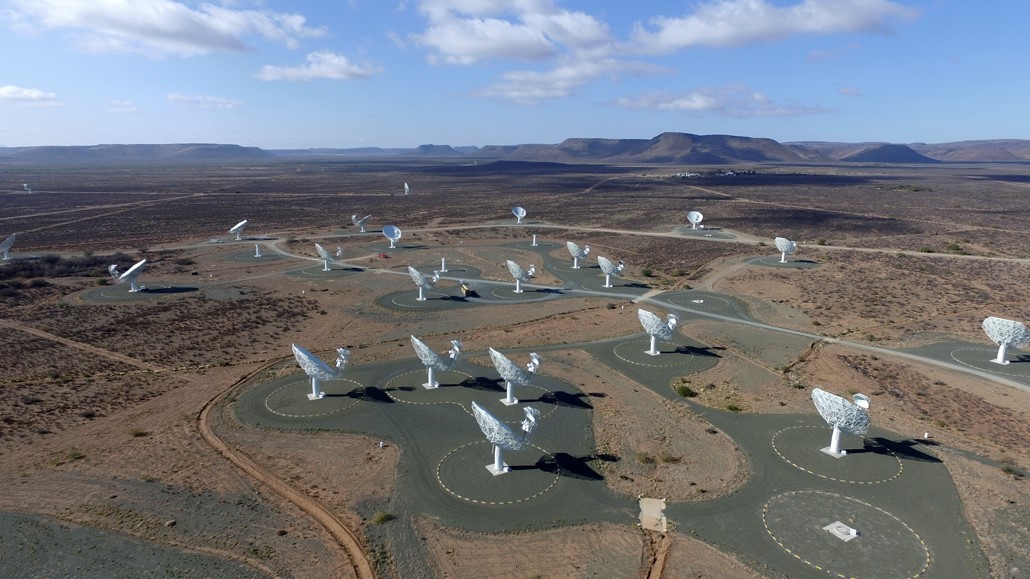MHONGOOSE begins to study the weak atomic gas that surrounds galaxies, key in their evolution
MHONGOOSE, a legacy project of the MeerKAT radiointerferometer, South African precursor to the Square Kilometer Array, produces its first results. They have been obtained in its preparatory phase, thus anticipating the window that will open to the understanding of the formation and evolution of galaxies
MHONGOOSE (MeerKAT Observations of Nearby Galactic Objects - Observing Southern Emitters) is a legacy project to study the distribution of atomic hydrogen (HI) in a selection of nearby galaxies using the MeerKAT radiotelescope (South Africa). As part of its testing phase, it has already provided its first scientific results. This first work, published in the journal Astronomy and Astrophysics, provides new findings on the distribution of gas around the galaxy ESO 302-G014 and shows the potential of the project.

MHONGOOSE will study how galaxies capture gas from their surroundings and the relationship between gas and star formation. To do so, the distribution of atomic hydrogen (HI) will be studied in a sample of 30 nearby galaxies, located less than 65 million light years from our Milky Way. The galaxies have been selected to cover all inclinations, from edge-on galaxies to front-on galaxies, and cover a very wide range in mass and luminosity.
This variety in the sample allows addressing various questions about the transformation and evolution processes of galaxies in the nearby universe. The project has obtained 1650 hours of observation in the MeerKAT radiointerferometer, a precursor of SKA (Square Kilometer Array) consisting of 64 antennas located in the Karoo desert, in South Africa. MeerKAT is, until SKA is built, the most efficient telescope to obtain the type of data that is needed in MHONGOOSE.
Gas Clouds Surrounding a Dwarf Galaxy in the Southern Hemisphere
The first results that MHONGOOSE provides correspond to the galaxy called ESO 302-G014, a nearby gas-rich dwarf galaxy. The international scientific team responsible for the work, which has the participation of the IAA-CSIC, has used observations made with MeerKAT, together with complementary data in other wavelengths, to study its evolutionary history. They have found that the galaxy has a thin, asymmetrical outer disk, as well as a tidal tail of atomic hydrogen and an isolated cloud about 6,500 light-years from this galaxy.
These structures, which had not been previously detected, seem to indicate that the galaxy underwent an interaction with another low mass galaxy. Lourdes Verdes-Montenegro, IAA-CSIC scientific researcher and the only Spanish member of the MHONGOOSE team, highlights that “the detected signs of a possible interaction with some low-mass galaxy companion are also supported by the presence of significant amounts of molecular gas detected by the ALMA interferometer and the existence of prominent star clusters, suggesting a recently induced star formation”.

"The deep images from the Dark Energy Camera Legacy Survey show a faint and diffuse object near the end of the filament, whose radius, brightness and color are compatible with that of a dwarf galaxy at a distance similar to that of ESO 302-G014", points out Javier Román, a researcher at the IAA-CSIC expert in deep optical images who participates in the work.
These results are, according to Lourdes Verdes-Montenegro, “just a small preview of things to come”, as they have been obtained with preliminary observations, and she is confident that “in-depth observations of the objects in the MHONGOOSE sample will offer a glimpse of the fate of atomic gas when transferring from the intergalactic medium to galaxies”. In the medium-term future, these types of observations will be able to be extended to more distant galaxies thanks to SKA, which will be the largest radiotelescope in the world, and in which MeerKAT will be integrated to form a single interferometer.
About the SKA
The Square Kilometer Array (SKA) project is an international effort to build the world's largest radiotelescope. The SKA is not a single telescope, but a collection of telescopes (an array), distributed over great distances and interconnected with each other to combine their signals using a technique called radiointerferometry. It will be built in South Africa and Western Australia, with subsequent expansion on both continents. The SKA will conduct science that will transform our understanding of the universe, including the formation and evolution of galaxies, fundamental physics in extreme environments, or the origins of life. SKA's design has been led by the SKA Organization headquartered at the legendary Jodrell Bank Observatory, near Manchester, UK, involving over 1,000 scientists and engineers from
more than 20 countries. The SKA Organization is transitioning to the SKA Observatory, an intergovernmental organization established by treaty, to undertake the construction and operation of the telescope. More information about the SKA can be found at this link.
de Blok et al. “MeerKAT HI commissioning observations of MHONGOOSE galaxy ESO 302-G014”. Astronomy & Astrophysics 643, A147 (2020) https://doi.org/10.1051/0004-6361/202038894
Instituto de Astrofísica de Andalucía (IAA-CSIC)
Unidad de Divulgación y Comunicación
Silbia López de Lacalle - sll[arroba]iaa.es - 958230676
https://www.iaa.csic.es
https://divulgacion.iaa.csic.es

